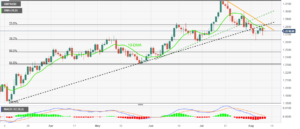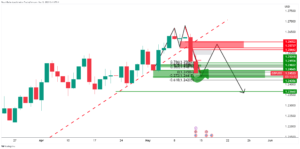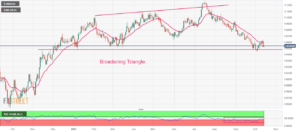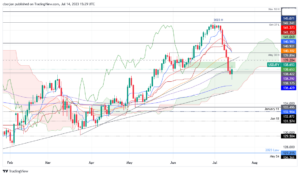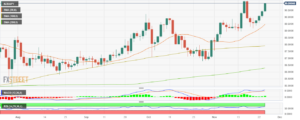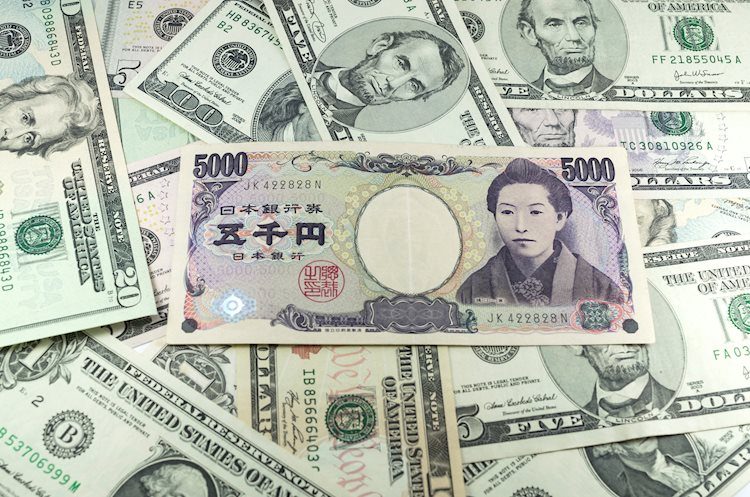
- The Japanese Yen benefits from the BoJ’s hawkish tilt on Tuesday, though lacks follow-through.
- Geopolitical tensions and the uncertain global economic outlook underpin the safe-haven JPY.
- Reduced bets for an early rate cut by the Fed lend support to the USD and the USD/JPY pair.
The Japanese Yen (JPY) ticks higher following the previous day's good two-way price swings, albeit lacks bullish conviction and remains confined in a familiar range during the Asian session on Wednesday. The Bank of Japan (BoJ) Governor Kazuo Ueda's comments during the post-meeting press conference suggested that conditions for phasing out huge stimulus and pulling short-term interest rates out of negative territory were falling into place. Apart from this, a larger-than-expected rise in Japan's exports and geopolitical tensions offer some support to the safe-haven JPY.
Meanwhile, the BoJ lowered its forecast for core consumer prices for fiscal 2024, tempering hopes for the need to immediately begin tightening the ultra-loose policy. This, in turn, might hold back the JPY bulls from placing aggressive bets, which, along with the underlying bullish sentiment surrounding the US Dollar (USD), should help limit the downside for the USD/JPY pair. Traders might also prefer to wait on the sidelines ahead of the top-tier US macro data, the Advance Q4 GDP print and the Core PCE Price Index, scheduled for release on Thursday and Friday, respectively.
Daily Digest Market Movers: Japanese Yen draws support from the fact that BoJ opened the door to end negative rates
- The Bank of Japan said on Tuesday that the likelihood of sustainably achieving the 2% inflation target was gradually increasing, laying the groundwork for monetary policy normalisation.
- The head of Japan's biggest business lobby Keidanren called for wage hikes this year that exceed the inflation rate, paving the way for the BoJ to pivot away from its ultra-easy policy.
- The global economic outlook, especially in China and Europe, remains uncertain, which, along with geopolitical tensions, is seen lending some support to the safe-haven Japanese Yen.
- Data released this Wednesday showed that Japan's exports rose 9.8% from a year earlier, with exports to China rising for the first time in 13 months and exports to the US hitting a record higher.
- The au Jibun Bank flash Japan Manufacturing PMI improved slightly to 48.0 in January from December's reading of 47.9, though remained in contraction territory for the eighth straight month.
- Meanwhile, the au Jibun Bank flash Services PMI rose from 51.5 to 52.7 in January, while the Composite PMI advanced to 51.1 during the reported month from 50.0 in December.
- US military forces struck 3 facilities used by Iranian-affiliated militant groups in western Iraq in direct response to a series of escalatory attacks against US forces in the Middle East.
- The US Dollar holds steady near a six-week peak touched on Tuesday amid expectations that the Federal Reserve will be in no hurry to cut rates in the wake of a resilient US economy.
- Traders now look to the release of flash PMI prints from the Eurozone and the US, which will provide a fresh insight into the global economic health and drive demand for the JPY.
- The focus, however, will remain on the Advance US Q4 GDP print and the US Core PCE Price Index – the Fed's preferred inflation gauge – due on Thursday and Friday, respectively.
Technical Analysis: USD/JPY awaits a breakout through the recent trading range before the next leg of a directional move
From a technical perspective, the USD/JPY pair's inability to build on the overnight bounce from sub-147.00 levels warrants some caution for bullish traders. Hence, it will be prudent to wait for some follow-through buying beyond the 148.80 region, or a multi-week top touched last Friday, before positioning for an extension of the recent move-up witnessed since the beginning of this month. Given that oscillators on the daily chart are holding comfortably in the positive territory and are still far from being in the overbought zone, spot prices might then aim to surpass an intermediate hurdle near the 149.30-149.35 zone and reclaim the 150.00 psychological mark for the first time since November 17.
On the flip side, the 100-day Simple Moving Average (SMA), currently around the 147.55 region, now seems to protect the immediate downside ahead of the 147.00 mark, or the overnight swing low. The next relevant support is pegged near the 146.60-146.55 area, below which the USD/JPY pair could weaken further towards the 146.10-146.00 horizontal support. The latter should act as a key pivotal point, which if broken decisively will negate any near-term positive outlook and shift the bias in favour of bearish traders.
Japanese Yen price today
The table below shows the percentage change of Japanese Yen (JPY) against listed major currencies today. Japanese Yen was the strongest against the Australian Dollar.
| USD | EUR | GBP | CAD | AUD | JPY | NZD | CHF | |
| USD | -0.02% | -0.03% | 0.04% | 0.08% | -0.09% | -0.05% | -0.02% | |
| EUR | 0.02% | -0.01% | 0.05% | 0.07% | -0.07% | -0.05% | -0.01% | |
| GBP | 0.03% | 0.01% | 0.06% | 0.08% | -0.07% | -0.04% | 0.00% | |
| CAD | -0.04% | -0.01% | -0.06% | 0.03% | -0.13% | -0.09% | -0.06% | |
| AUD | -0.07% | -0.08% | -0.10% | -0.04% | -0.12% | -0.14% | -0.10% | |
| JPY | 0.08% | 0.07% | 0.08% | 0.11% | 0.18% | 0.02% | 0.06% | |
| NZD | 0.06% | 0.02% | 0.01% | 0.08% | 0.13% | -0.03% | 0.01% | |
| CHF | 0.02% | 0.00% | -0.01% | 0.06% | 0.10% | -0.07% | -0.03% |
The heat map shows percentage changes of major currencies against each other. The base currency is picked from the left column, while the quote currency is picked from the top row. For example, if you pick the Euro from the left column and move along the horizontal line to the Japanese Yen, the percentage change displayed in the box will represent EUR (base)/JPY (quote).
Japanese Yen FAQs
The Japanese Yen (JPY) is one of the world’s most traded currencies. Its value is broadly determined by the performance of the Japanese economy, but more specifically by the Bank of Japan’s policy, the differential between Japanese and US bond yields, or risk sentiment among traders, among other factors.
One of the Bank of Japan’s mandates is currency control, so its moves are key for the Yen. The BoJ has directly intervened in currency markets sometimes, generally to lower the value of the Yen, although it refrains from doing it often due to political concerns of its main trading partners. The current BoJ ultra-loose monetary policy, based on massive stimulus to the economy, has caused the Yen to depreciate against its main currency peers. This process has exacerbated more recently due to an increasing policy divergence between the Bank of Japan and other main central banks, which have opted to increase interest rates sharply to fight decades-high levels of inflation.
The BoJ’s stance of sticking to ultra-loose monetary policy has led to a widening policy divergence with other central banks, particularly with the US Federal Reserve. This supports a widening of the differential between the 10-year US and Japanese bonds, which favors the US Dollar against the Japanese Yen.
The Japanese Yen is often seen as a safe-haven investment. This means that in times of market stress, investors are more likely to put their money in the Japanese currency due to its supposed reliability and stability. Turbulent times are likely to strengthen the Yen’s value against other currencies seen as more risky to invest in.
- SEO Powered Content & PR Distribution. Get Amplified Today.
- PlatoData.Network Vertical Generative Ai. Empower Yourself. Access Here.
- PlatoAiStream. Web3 Intelligence. Knowledge Amplified. Access Here.
- PlatoESG. Carbon, CleanTech, Energy, Environment, Solar, Waste Management. Access Here.
- PlatoHealth. Biotech and Clinical Trials Intelligence. Access Here.
- Source: https://www.fxstreet.com/news/japanese-yen-remains-confined-in-a-one-week-old-trading-range-against-usd-202401240146
- :has
- :is
- 1
- 13
- 150
- 17
- 2%
- 2% Inflation
- 2024
- 31
- 32
- 35%
- 36
- 41
- 50
- 51
- 52
- 7
- 80
- 9
- a
- achieving
- Act
- advance
- advanced
- against
- aggressive
- ahead
- aim
- along
- also
- Although
- Amid
- among
- an
- analysis
- and
- Animate
- any
- apart
- ARE
- AREA
- around
- AS
- asian
- Attacks
- Australian
- Australian dollar
- average
- away
- back
- Bank
- bank of japan
- Bank of Japan (BoJ)
- Banks
- base
- based
- BE
- bearish
- before
- begin
- Beginning
- being
- below
- benefits
- Bets
- between
- Beyond
- bias
- Biggest
- boj
- bond
- Bond yields
- Bonds
- Bounce
- Box
- breakout
- broadly
- Broken
- build
- Bullish
- Bulls
- business
- but
- Buying
- by
- called
- caused
- caution
- central
- Central Banks
- change
- Changes
- China
- Column
- comments
- Concerns
- conditions
- Conference
- consumer
- content
- contraction
- control
- conviction
- Core
- could
- currencies
- Currency
- currency markets
- Current
- Currently
- Cut
- daily
- data
- day
- December
- Demand
- depreciate
- determined
- Digest
- direct
- directional
- directly
- displayed
- Divergence
- doing
- Dollar
- Door
- downside
- draws
- drive
- due
- during
- each
- Earlier
- Early
- East
- Economic
- economy
- Eighth
- end
- ends
- especially
- EUR
- Euro
- Europe
- Eurozone
- example
- exceed
- expanded
- expectations
- exports
- extension
- facilities
- fact
- factors
- Falling
- familiar
- FAQ
- far
- favors
- Fed
- Federal
- federal reserve
- fight
- First
- first time
- Fiscal
- Flash
- Flip
- Focus
- following
- For
- Forces
- Forecast
- fresh
- Friday
- from
- further
- gauge
- GDP
- generally
- geopolitical
- given
- Global
- Global Economic
- good
- Governor
- gradually
- groundwork
- Group’s
- Have
- Hawkish
- head
- Health
- help
- hence
- higher
- Hikes
- hitting
- hold
- holding
- holds
- hopes
- Horizontal
- However
- HTTPS
- huge
- hurdle
- if
- immediate
- immediately
- improved
- in
- inability
- Increase
- increasing
- index
- inflation
- inflation rate
- insight
- interest
- Interest Rates
- Intermediate
- into
- Invest
- investment
- Investors
- iraq
- IT
- ITS
- January
- Japan
- Japan Manufacturing PMI
- Japan’s
- Japanese
- Japanese Yen
- jpg
- JPY
- Key
- Last
- laying
- Led
- left
- LEND
- lending
- levels
- likelihood
- likely
- LIMIT
- Line
- Listed
- Lobby
- Look
- Low
- lower
- lowered
- Macro
- Main
- major
- mandates
- manufacturing
- map
- mark
- Market
- Markets
- massive
- means
- Middle
- Middle East
- might
- Military
- module
- Monetary
- Monetary Policy
- money
- Month
- months
- more
- most
- move
- Movers
- moves
- moving
- moving average
- Near
- Need
- negative
- negative territory
- next
- no
- November
- now
- of
- offer
- often
- on
- ONE
- opened
- or
- Other
- out
- Outlook
- overnight
- pair
- particularly
- partners
- Paving
- pce
- Peak
- peers
- pegged
- percentage
- performance
- perspective
- pick
- picked
- Pivot
- pivotal
- Place
- placing
- plato
- Plato Data Intelligence
- PlatoData
- pmi
- Point
- policy
- political
- positioning
- positive
- prefer
- preferred
- press
- previous
- price
- Prices
- prints
- process
- protect
- provide
- psychological
- pulling
- put
- quote
- range
- Rate
- Rates
- Reading
- recent
- recently
- record
- region
- release
- released
- relevant
- reliability
- remain
- remained
- remains
- Reported
- represent
- Reserve
- resilient
- respectively
- response
- Rise
- rising
- Risk
- Risky
- ROSE
- ROW
- s
- Said
- scheduled
- seems
- seen
- sentiment
- Series
- Services
- session
- shift
- short-term
- should
- showed
- Shows
- side
- Simple
- since
- SMA
- So
- some
- sometimes
- specifically
- Spot
- Spot Prices
- Stability
- stance
- starts
- steady
- sticking
- Still
- stimulus
- straight
- Strengthen
- stress
- strongest
- support
- Supports
- supposed
- surpass
- Surrounding
- sustainably
- Swing
- Swings
- table
- Target
- Technical
- tensions
- territory
- that
- The
- the Fed
- The US Federal Reserve
- their
- then
- this
- this year
- though?
- Through
- thursday
- tightening
- time
- times
- to
- today
- top
- touched
- towards
- traded
- Traders
- Trading
- Tuesday
- turbulent
- TURN
- Uncertain
- underlying
- underpin
- us
- US bond yields
- US Core PCE
- US Core PCE Price Index
- US Dollar
- US economy
- US Federal
- us federal reserve
- USD
- USD/JPY
- used
- value
- wage
- wait
- Wake
- Warrants
- was
- Way..
- Wednesday
- were
- Western
- which
- while
- will
- with
- witnessed
- world’s
- year
- Yen
- yields
- you
- zephyrnet

